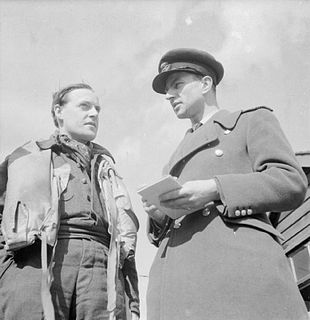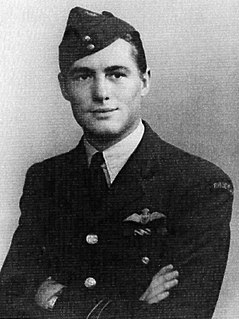
Wing Commander Lance Cleo "Wildcat" Wade DSO, DFC & Two Bars was an American pilot who joined the Royal Air Force (RAF) during World War II and became a flying ace. He remained with RAF until his death in a flying accident in 1944 in Italy. He was described as a "distinguished American fighter ace who epitomized perhaps more than any other American airman the wartime accords between Britain and the United States."
Squadron Leader Hedley George "Hazel" Hazelden DFC and bar was a British test pilot.

Air Marshal Sir Harold Brownlow Morgan "Micky" Martin, was an Australian bomber pilot and senior commander in the Royal Air Force (RAF). He took part in Operation Chastise, the RAF's "Dambusters" raid in 1943, and was described by journalist Sir Max Hastings as "one of the three great bomber pilots of the war". He rose to become a senior officer in the RAF, commanding RAF Germany and later serving as Air Member for Personnel, a member of the Air Council, the RAF's controlling body.
Squadron Leader Henry Melvin "Dinghy" Young, was a bomber pilot in the Royal Air Force Volunteer Reserve during the Second World War.
Air Commodore James Rankin, was a Royal Air Force officer, fighter pilot and flying ace of the Second World War.

Air Commodore Peter Malam "Pete" Brothers, was a Royal Air Force fighter pilot and flying ace of the Second World War. Brothers was credited with 16 aerial victories, 10 of which he achieved during the Battle of Britain.
Air Commodore John Marlow Thompson, was a Royal Air Force (RAF) officer and a flying ace of the Second World War.
Air Marshal Sir Denis Crowley-Milling, was a Second World War fighter pilot and later an air officer in the Royal Air Force.
Squadron Leader Denis "Dusty" Miller DSO DFC was a New Zealand bomber and airline pilot.

James Archibald Findlay MacLachlan was a Royal Air Force (RAF) fighter pilot and flying ace of the Second World War. MacLachlan was credited with 16 German and Italian aircraft shot down in approximately 250 missions—7 were at night of which two were achieved over Malta in 1941 and 5 over France in 1942.
Squadron Leader John Stanley Booth DFC* was an English aviator, a pilot in the Royal Air Force during the Second World War, and, after the end of the conflict, became a test pilot. After spending almost ten years working for the Saunders-Roe company, he was killed in 1958 while test flying the SR.53, an experimental interceptor.
Wing Commander John Robert Baldwin, was a Royal Air Force fighter pilot and the top scoring fighter ace flying the Hawker Typhoon exclusively during the Second World War. He was posted missing, presumed killed, during secondment service with the United States Air Force in the Korean War.
Alfred William "Gordon" Cochrane, was an officer of the Royal New Zealand Air Force (RNZAF) during the Second World War. He is one of only four New Zealand-born airmen to receive two medal bars to his Distinguished Flying Cross.
Air Vice Marshal Edward Dixon Crew & Bar, DFC & Bar was a Royal Air Force officer and a nightfighter ace of the Second World War. He shot down 15 enemy aircraft and was one of the top-scoring aces against the V-1 flying bomb.
David Mattingley, DFC was an Australian bomber pilot who flew for the Royal Australian Air Force in the British No. 625 Squadron during World War II in which he received the Distinguished Flying Cross.
Wing Commander David William Holford was a Royal Air Force officer who was the youngest bomber squadron commanding officer in RAF history. He was killed after crashing his Lancaster in thick fog near Kelstern following an operation to bomb Berlin.

Kenneth Tempest DFC was a Royal Air Force navigator with 139 Squadron during the Second World War flying Mosquitos. He was awarded the Distinguished Flying Cross for his service. After the war he trained as a pilot and flew with BOAC in the Bristol Britannia and the VC10.

Squadron Leader Daniel Trevor Bulmer "Danny" Everett, DFC and 2 Bars, was a leading Royal Air Force Bomber Command and Pathfinder Force pilot and bombing leader, decorated three times for gallantry before being killed in action.
Osgood Philip Villiers "Pedro" Hanbury, was a Royal Air Force flying ace of the Second World War. He had scored 11 victories before he was killed in action in 1943.

Patrick Arthur Dorehill, was an officer in the Royal Air Force. A bomber pilot, he flew as flight engineer for John Nettleton during the Augsburg raid, where they carried out a daring daylight attack against the MAN U-boat engine plant at Augsburg in southern Germany, earning him an immediate DFC and his captain the Victoria Cross. He went on to complete two full combat tours as a bomber pilot. With his commitment to combat flying completed, he was transferred to the BOAC where he flew transports. Following the war Dorehill had a lengthy career as a commercial airline pilot.












